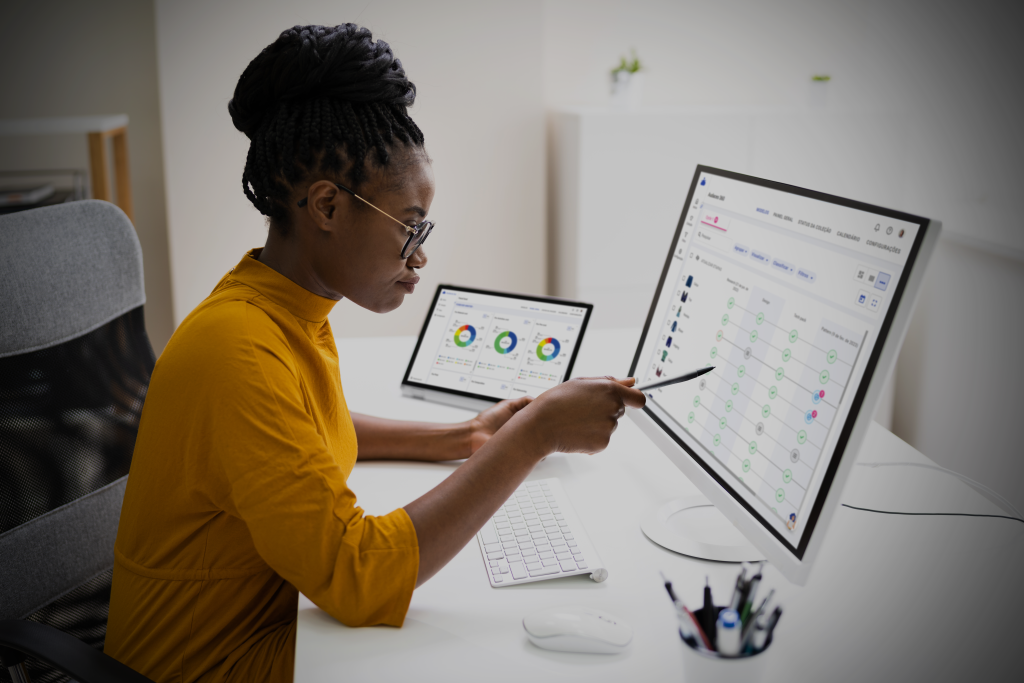Summary:
- The fashion industry is in a constant state of change, and, in the future, it will face significant organizational, social, and environmental challenges;
- Prioritizing social well-being, minimizing waste, and investing in the quality and durability of garments are among the key measures to be taken for the future of fashion;
- Technology can play a crucial role in this process. Experience it for yourself with our multi-solution Audaces360, available for a free trial.

The companies operating in the textile and clothing industries are constantly being challenged by the evolving market and changing consumer behavior.
Additionally, global value chains are continuously evolving, creating new connections. Let’s explore these topics further.
Enjoy reading!
Why companies must pay attention to future fashion demands?
The companies of the future will be adaptive businesses, capable not only of reacting quickly to changes but also of creating and influencing them. This is why it is crucial for firms to act in the present while keeping a vigilant eye on the future.
Sumário
This is especially true for the fashion industry, which is heavily influenced by both changing trends and processes, with a significant impact on digital transformation and technology.
Changes in consumption patterns, diversification of sales channels, virtual fashion, and increasing demands for environmental and social sustainability are all trends that are significantly shaping the fashion world. These trends are predicted to become the norm in just a few years.
Implementing these demands within their own processes will be necessary for companies to avoid the risk of being excluded from the market.
Learn more: How to master sustainable creation and production in the eco-fashion era
What should companies keep in mind for the future of fashion?
While it may be impossible to foresee all the specific forms that fashion will take in the future, there are essential topics that companies will need to address in the coming years.
Adjusting to these aspects will be a fundamental requirement for companies of all sizes.
Let’s explore some of the key aspects below!
Prioritize social well-being

Promoting social well-being in the workplace will be a central focus in the future, encompassing both the welfare of employees and customers.
From the perspective of workers, especially in the aftermath of the pandemic, the significance of working in a healthy environment that safeguards their physical, psychological, and social well-being has been underscored.
The widespread phenomenon of “the great resignation” has placed companies in the position of prioritizing the welfare of their employees. Failing to do so risks facing challenges in attracting and retaining talent.
From the viewpoint of customers, documentaries like “The True Cost” and movements like Fashion Revolution have shed light on the fashion industry, demanding comprehensive protection of the environment and employees.
This expectation applies to companies worldwide but is particularly crucial for those operating in countries where even basic rights related to safety and fair wages are not guaranteed. It is disconcerting that the majority of fashion workers, especially women, in the world still earn less than $3 per day.
Learn more: Find out what Fashion Revolution is and the purpose of the movement
Minimize waste
The issue of fashion sustainability, being the second most polluting sector on our planet, calls for significant action.
In the words of Silvia Andreani, Client Officer of Luxury Fashion and Beauty at Ipsos, during Wired Trends 2023, sustainability is not just a trend but a categorical imperative. Consumers perceive fashion as the fifth most polluting industry, while in reality, it holds the second position. In a survey, 49% of respondents expressed their willingness to pay more for products from brands that demonstrate ethical and environmentally sustainable commitments.
Considerable efforts can be made to reduce waste in the fashion industry, with a focus on consumer behavior. For instance, the average American citizen discards approximately 80 kg of textile waste each year.
This highlights the need for a cultural shift, particularly in Western societies, where transformative change is essential.
The fashion industry will require comprehensive actions to minimize waste throughout the entire supply chain. This includes garment design, production, distribution, and post-sales processes. Professionals in the field of sustainable fashion jobs will play a crucial role in driving this change.
Learn more: What circular fashion is and why you should implement it in manufacturing
Create durable fashion

Minimizing waste is essential but not the sole factor in addressing the challenges of the fashion industry.
According to McKinsey’s study “The State of Fashion”, if significant measures to reduce waste are not taken, the increase in production and trade volumes could result in approximately 2.7 billion tons of waste annually by 2030.
In the future of fashion, the excessive production of low-quality garments will be replaced by the creation of durable and higher-quality pieces designed to withstand the test of time and changing trends.
Achieving this goal will require a comprehensive overhaul of all processes, from the sourcing of raw materials to the design and actual production of the garments.
One natural consequence of such a transformative change will be an increase in garment prices.
This makes it even more crucial to maximize efficiency within the industry to reduce waste and unnecessary rework.
Learn more: Find out how fast fashion and sustainability can coexist in the apparel industry
Proper waste disposal
According to the study by McKinsey, in 2022, Europe generated an average of fifteen kilograms of textile waste per capita. The main source of this waste is discarded clothing and household fabrics from consumers, accounting for approximately 85% of the total waste.
Unfortunately, the disposal of these textiles poses significant challenges, often leading to their incineration or landfilling both within and outside Europe.
Even before reaching consumers, there is a significant amount of pre-consumer waste, which includes unsold new garments that cannot be kept in the market.
Disturbing images of mountains of textile waste in locations such as the Atacama Desert in Chile and the beaches of Accra in Ghana have garnered attention, with the toxic smoke and pollution from these waste sites posing a threat to aquifers.
It is essential to ensure that these images do not become a part of our future, as we strive to preserve the health of our planet.
Currently, only 20% of fabrics are being recycled. In the future, there must be a concerted effort to increase this percentage, starting from the design phase by making conscious choices of yarns and materials.
Learn more: Why consider sustainable consumption and production for your company?
What advantages does technology offer for the fashion future?
Embracing the future and addressing its challenges requires a comprehensive transformation that spans cultural, organizational, productive, and technological aspects.
Technology offers numerous tangible tools to support this transformative process across multiple fronts.
Let’s explore some of these advantages below:
Increased agility and productivity

Today, various technological tools are available to connect different functions within a company, improving agility and productivity in processes. Integration serves as the initial step towards better organizing production, ensuring efficiency and competitiveness in the market.
Industry 4.0 has brought significant advancements in this direction, allowing for precise data-driven planning and process management. It enables the detection of inefficiencies and bottlenecks across the entire supply chain, resulting in accelerated production and delivery times.
Remarkably, all of this can be achieved while simultaneously improving the quality of results. It may seem impossible, but it represents the future of fashion (and to some extent, the present).
Learn more: Find out how futuristic fashion is revolutionizing the industry with technology
Process automation
Automation involves leveraging machines and technology to support manual work, enhancing productivity in the industry, especially in repetitive and labor-intensive tasks.
In Italy, for example, there is still much to be done in terms of automation, which represents a crucial opportunity for the future and helps prevent production relocation.
You may wonder how this can be achieved. One approach is to create more flexible and dynamic production lines, reducing the need for inefficient and unsustainable one-size-fits-all production.
Here are some possibilities offered by textile automation that can contribute to improving your company across various areas:
- Integration of teams and data sharing
- Material control and monitoring, including inventory management
- Utilization of software for pattern making and cutting
- Quality control
Learn more: Find out how – and why – to apply textile automation in your company
Error reduction and less rework
Technology enables greater precision in work and facilitates continuous monitoring of processes, leading to quick identification and resolution of errors.
Many mistakes can be avoided through the use of technology, particularly in cases involving communication errors or inaccuracies in measurements and garment details.
Today, there are software solutions that can realistically simulate the final outcome of garment patterns during the planning stage, reducing misunderstandings between design teams and sample rooms and minimizing material waste.
Additionally, Product Lifecycle Management (PLM) systems can track the production progress of all garments within a collection, integrating information across multiple departments.
Learn more: Discover the benefits of digital sewing patterns and how they work
Ease in making changes
In traditional manual work, making changes to a garment design can be a time-consuming process. It often involves redoing the pattern, developing new sizes, and recreating the prototype, with the risk of the final result not meeting expectations.
Nowadays, technology enables changes to be made directly on the computer, saving significant time and effort. With just a few seconds, designers can modify designs, expand their creative possibilities, and reduce the need for extensive rework.

Embrace the fashion future with Audaces technology!
Audaces is a renowned global leader in innovative technology for the fashion industry. Our cutting-edge solutions are designed to anticipate future demands and empower companies in the sector to achieve long-term competitiveness.
By reducing inefficiencies and alleviating the pressures of a highly ambitious and fast-paced market, Audaces technology paves the way for success.
Through automation and digitization of productive processes, Audaces solutions enable workers to increase productivity and achieve higher-quality results. This not only enhances overall performance but also promotes the well-being of the workforce.
Cutting Room
The Cutting Room automation is a game-changer for companies in the fashion industry. It brings remarkable precision to the cutting process and ensures thorough quality checks. Additionally, it optimizes fabric usage, minimizing waste and eliminating the need for reworks.
The pieces that emerge from the cutting room are ready to be sewn, requiring no further adjustments. These advantages enable companies that invest in automation to achieve a faster return on their initial investment in equipment.
Audaces360
Audaces360 takes integration and automation in the fashion production chain to a superior level.
From the creative stage to the development of technical cards, cost and feasibility forecasts, and model creation, Audaces360 allows for easy, fast, and optimized visibility and management of your collections. It equips you with the tools of the future to work efficiently in the present.
Whether you are a stylist, manager, assistant, technician, or pattern maker, Audaces360 provides the solution to overcome the challenges of the fashion market.
If you want to delve deeper into the future of fashion and learn how to strategically plan the development of your company, don’t miss out on our free e-book. Simply fill out the form below to access valuable insights:
FAQ
Clothing manufacturing is vital for the fashion industry to stay competitive and meet evolving trends and consumer expectations.
Companies should prioritize social well-being, minimize waste, produce durable garments, and ensure responsible waste disposal for a sustainable fashion future.
Technology enhances agility, productivity, and precision in manufacturing, reducing errors and simplifying design changes, enabling companies to adapt quickly and innovate in response to market demands.










